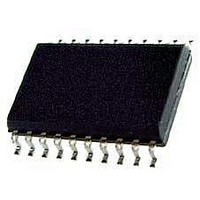M3004LD STMicroelectronics, M3004LD Datasheet - Page 2

M3004LD
Manufacturer Part Number
M3004LD
Description
Communication ICs - Various Remote Control Transmitter
Manufacturer
STMicroelectronics
Type
Remote Control Transmitterr
Datasheet
1.M3004LD.pdf
(14 pages)
Specifications of M3004LD
Mounting Style
SMD/SMT
Operating Supply Voltage
2.5 V, 3.3 V, 5 V
Supply Type
Analog
Package / Case
SO-20
Supply Voltage (max)
6.5 V
Supply Voltage (min)
2 V
Supply Current
1 mA
Maximum Operating Temperature
+ 70 C
Minimum Operating Temperature
- 20 C
Operating Supply Voltage (typ)
2.5/3.3/5V
Operating Supply Voltage (min)
2V
Operating Supply Voltage (max)
6.5V
Operating Temp Range
-20C to 70C
Operating Temperature Classification
Commercial
Package Type
SOIC
Mounting
Surface Mount
Pin Count
20
Lead Free Status / RoHS Status
Lead free / RoHS Compliant
Available stocks
Company
Part Number
Manufacturer
Quantity
Price
Part Number:
M3004LD
Manufacturer:
ST
Quantity:
20 000
Company:
Part Number:
M3004LDT
Manufacturer:
SUMIDA
Quantity:
30 000
M3004
Figure 3. Block Diagram
INPUTS AND OUTPUTS
Key matrix inputs and outputs (DRV0N to
DRV6N and SEN0N to SEN6N)
The transmitter keyboard is arranged as a
scanned matrix. The matrix consists of 7 driver
outputs and 7 sense inputs as shown in Figure 4.
The driver outputs DRV0N to DRV6N are open
drain N-channel transistors and they are conduc-
tive in the stand-by mode. The 7 sense inputs
(SEN0N to SEN6N) enable the generation of 56
command codes. With 2 external diodes all 64
commands are addressable. The sense inputs
have P-channel pull-up transistors so that they are
HIGH until they are pulled LOW by connecting
them to an output via a key depression to initiate a
code transmission.
ADDRESS MODE INPUT (ADRM)
The sub-system address and the transmission
mode are defined by connecting the ADRM input
to one or more driver outputs (DRV0N to DRV6N)
of the key matrix. If more than one driver is con-
nected to ADRM, they must be decoupled by di-
odes. This allows the definition of seven sub-
system addresses as shown in Table 3. If driver
DRV6N is connected to ADRM, the data output
2/14
S
E
N
N
P
U
S
T
I
V
V
DD
SS
0N
1N
2N
3N
4N
5N
6N
0N 1N 2N 3N 4N 5N 6N
ADRM
DRV OUTPUTS
KEYBOARD
OSCILLATOR
OSCI OSCO
SCAN
format of REMO is modulated or if not connected,
flashed.
The ADRM input has switched pull-up and pull-
down loads. In the stand-by mode only the pull-
down device is active. Whether ADRM is open
(sub-system address 0, flashed mode) or connect-
ed to the driver outputs, this input is LOW and will
not cause unwanted dissipation. When the trans-
mitter becomes active by pressing a key, the pull-
down device is switched off and the pull-up device
is switched on, so that the applied driver signals
are sensed for the decoding of the sub-system ad-
dress and the mode of transmission.
The arrangement of the sub-system address cod-
ing is such that only the driver DRVnM with the
highest number (n) defines the sub-system ad-
dress, e.g. if drivers DRV2N and DRV4N are con-
nected to ADRM, only DRV4N will define the sub-
system address. This option can be used in sys-
tems requiring more than one sub-system ad-
dress. The transmitter may be hard-wired for
subsystem address 2 by connecting DRV1N to
ADRM. If now DRV3N is added to ADRM by a key
or a switch, the transmitted sub-system address
changes to 4. A change of the sub-system address
will not start a transmission.
MODULATOR
DISTANCE
CONTROL
PULSE
LOGIC
REMO
OUTPUT













